|

by Goro Adachi
August 9, 2003
from
Etemenanki Website
Introduction
What lies at the core of the ‘Time River Theory’ is more than just a
theory, but a factual ‘smoking gun’ capable of utterly decimating
what is being passed off as ‘reality’ today. The Time River Theory
is undoubtedly an ‘extraordinary claim’.
But it is one that is
supported by ‘extraordinary evidence’.
Indeed, it is this author’s
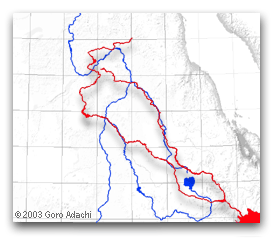 position
that the discovery of the Time Rivers heralds the last tick of the
‘time bomb’ that ends the illusion of the ‘Matrix’, so to speak. The
new reality lets us discern who we really are, where we came from,
and where we are going. position
that the discovery of the Time Rivers heralds the last tick of the
‘time bomb’ that ends the illusion of the ‘Matrix’, so to speak. The
new reality lets us discern who we really are, where we came from,
and where we are going.
The Time River Theory primarily involves two ancient river
systems: the Nile in Africa and the Tigris-Euphrates in the land of
Mesopotamia.
By the end of this paper, the reader will come to
understand the explosive implication of the strange configuration
depicted in the image right - that our planet’s major rivers have
been intelligently designed. It would represent the closest thing
mankind has seen to the ‘fingerprints of the gods’.
The strength of the theory lies in the fact that its basic claim can
be presented concisely and understood by the average people without
much difficulty. It is the unusual combination of clarity and
seeming impossibility that makes this ‘extraordinary claim’
extraordinarily plausible, if not undeniable.
It would ultimately
come down to the question:
‘Do you believe your own eyes or not?’
It is of course ridiculous to think that major rivers such as the
Nile are intelligently created ‘monuments’ bearing encoded messages.
But that is exactly what is logically demanded by the body of
evidence presented in this paper.
The Nile or denial - that may already be the real issue.
Having expressed the level of confidence, the author would like to
sincerely encourage all to critically examine the following
discussion, designed to present a key portion of the Time River
Theory.
For a complete presentation of the wide-ranging theory and its
unsettling implications for our own time, please see the book
The
Time Rivers (2003) by the author.
Hints of
Intelligent Design
Shown below is an overview map of the Nile in Africa, the world’s
longest river.
This is the ancient river that gave rise to the
mysterious ancient Egyptian civilization thousands of years ago.

And here are the initial clues hinting
at the existence of intelligence behind the river’s layout:
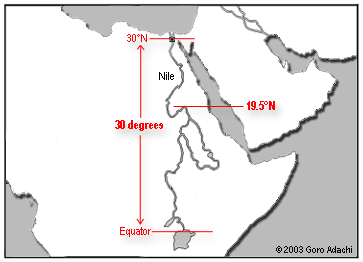
-
The Nile is distinctively
vertical (longitudinal), and it is the only notable river on
this planet to flow directly northward.
-
The Nile begins at the equator
and disintegrates precisely at 30°N latitude, marked by
Egypt’s capital Cairo and Giza, the home of the great
pyramids and the Sphinx.[1]
-
The generally straight Nile
makes a dramatic turn southward near the halfway point. The
northern peak of this remarkable bend - sometimes referred
to as the ‘Great Bend’ - pinpoints latitude 19.5°N.
The significance of #3 comes from the
fact that 19.5° is considered a ‘tetrahedral constant’, deriving
from the geometric configuration of a circumscribed tetrahedron
shown below.
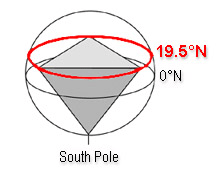
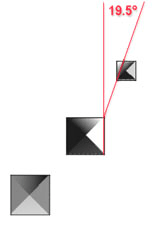 In
terms of the ‘hyperdimensional physics’ model promoted by researcher
Richard Hoagland, well known for his investigation into the
‘monuments of Mars’, the angle even represents an inter-dimensional
‘gateway’ of some sort. This notion is echoed by the great pyramids
at Giza - a place traditionally signifying a 'gateway' (Rostau) - in
that their layout prominently produces this very angle. In
terms of the ‘hyperdimensional physics’ model promoted by researcher
Richard Hoagland, well known for his investigation into the
‘monuments of Mars’, the angle even represents an inter-dimensional
‘gateway’ of some sort. This notion is echoed by the great pyramids
at Giza - a place traditionally signifying a 'gateway' (Rostau) - in
that their layout prominently produces this very angle.
The fact that the longitude pinpointed by the same Bend’s peak is
33.0°E intensifies our curiosity as ‘33’ too happens to be a key
number detected by Hoagland’s team, The Enterprise Mission.
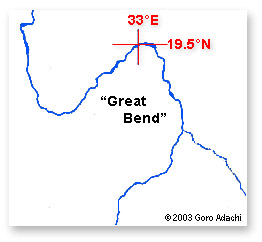
Indeed, 19.5 and 33 are said to be the two ‘ritual numbers’
repeatedly encoded into various aspects of NASA space missions.
In 1997, for example, the
Pathfinder space probe landed on Mars at almost exactly 19.5°N.
33°W.
That this was no coincidence is evidenced by the fact that:
-
the lander dropped on the ‘tetrahedral latitude’ was tetrahedral in
shape.
-
at the moment of touchdown, Earth was positioned 19.5°
above the eastern Martian horizon as seen from the landing site.
As Mike Bara, Hoagland’s right-hand man at the Enterprise Mission,
wrote:
Pathfinder’s unique tetrahedral
spacecraft design geometry, coupled with the totally “recursive”
tetrahedral geometry of the landing site itself, was obviously
intended by NASA “ritualists” behind the scenes to celebrate - on their first return to Mars in over twenty years
- the two key Hyperdimensional numbers underlying all the NASA rituals
- “19.5” and “33.”[2]
Whether or not NASA intentionally
conducts such ‘rituals’ is still a contentious issue, of course. But
the coincidence of the two numbers is difficult to ignore.
Where
there is smoke, as they say, there is usually fire.
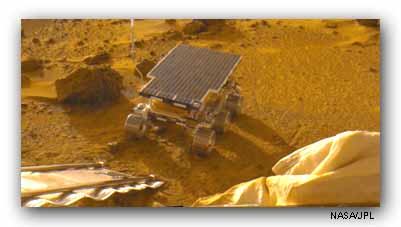
So how should we interpret these
geographical hints provided by the Nile? Are we to believe that the
Nile is a 'monument' carrying some sort of message?
While admittedly a wild speculation, this is certainly not the first
time such an idea has been put forward.
There is, for example, researcher Livio
Catullo Stecchini, whose view is presented in Peter Tompkin’s Secrets of the Great Pyramid:
The Egyptians were proud that their
country had some unique geographic features which could be
expressed in rigorous geometric terms and had a shape which
related to the order of the cosmos as they saw it.
They believed
that when the gods created the cosmos they began by building
Egypt and, having created it perfect, modeled the rest around
it. …[The] Egyptians put great stress also on the geographic
peculiarities of the course of the Nile.[3]
So the question is: Are these Nilotic
‘peculiarities’ a result of some deliberate design? Did the ‘gods’
literally construct the Nile and encode into its layout their cosmic
knowledge?
Throughout history much has been said about ancient monuments - such
as those at Giza (the pyramids and Sphinx) - bearing very advanced
knowledge surpassing all that came afterward. It is of course a
controversial view that many find uncomfortable.
But it pales in comparison to the much
crazier possibility emerging here... that the world’s longest river,
clearly visible from space, may be a gigantic ‘monument’!
A Literal
‘River of Time’?
Suspending our disbelief for a moment, let us ponder just what the
encoded ‘cosmic knowledge’ may be. What kind of information could be
so important as to be transmitted this way?
This question leads us to the next clue. As noted earlier, the
latitudinal length of the Nile is almost exactly 30 degrees.
The number ‘30’ happens to be closely
attached to the notion of time:
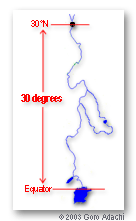
-
Saturn, traditionally considered the
god/planet of time, has an orbital period of ~30 years.[4]
-
One month - the Moon’s orbit around
Earth - is approximately 30 days. (In ancient Egypt, each month
was exactly 30 days.)
-
The apparent path of the sun in the
sky (the ecliptic) is traditionally divided into twelve zodiacal
‘signs’ (Pisces, Aires, Taurus, etc.), 30 degrees each,
corresponding to the sun’s movement in two hours. (The
Babylonians, the Chinese, etc. actually divided the day into not
24 but 12 equal parts, and so one subdivision of the day
corresponded to 30 degrees [i.e. 360/12=30].)
-
The seb festival of the ancient
Egyptians, commemorating the symbolic death/renewal of the king,
was held in the 30th year of the reign.[5]
So the implication here is that the Nile
is to be viewed as a ‘river of time’. This is poetically appealing
at least. After all, it is often said that ‘a river is like the flow
of time’.[6]
The above interpretation is reinforced by certain information
transmitted by Plutarch, a renowned Greek writer and biographer from
around AD 100.
It concerns Saturn, the god of time, who
was called ‘Cronus’ in Greek (related to the term ‘Chronos’ meaning
‘time’[7]):
There is also a religious lament
sung over Cronus. The lament is for him that is born in the
regions of the left, and suffers dissolution in the regions on
the right; for the Egyptians believe that the eastern regions
are the face of the world, the northern the right, and the
southern to the left. The Nile, therefore, which runs from the
south and is swallowed up by the sea in the north, is naturally
said to have its birth on the left and its dissolution on the
right.[8]
Not only does Plutarch reveal here that
Cronus/time arises in the south and ends in the north just like the
Nile, he even goes on to draw a direct parallel between Cronus/time
and the Nile!
This is almost an open and direct
acknowledgement that the Nile may indeed represent the flow of time.
God of Time,
God of the Nile
Another telling clue is found in the fact that various mythological
gods associated with time are also often associated with the Nile.
For instance:
-
Cronus-Saturn’s otherworldly domain
called Ogygia is applicable to the Nile since the river was
similarly called ‘Ogygian’ by the ancient Greek writer
Aeschylus.[9]
-
The Moon, associated with the
‘temporal number’ 30 via its orbital period (30 days), is
traditionally identified with the Egyptian god of wisdom called
Thoth. Not only was Thoth considered the measurer of time, he
was also represented by the ibis, an animal closely associated
with the Nile.[10]
-
More striking is Osiris, the most
revered and complex deity in ancient Egypt, popularly described
as the god of the dead.
-
Osiris is quite simply the ‘god of
the Nile’. This can be established through his traditional
identification with Apis and Hapi, both considered to embody the
Nile. Osiris was also known as Serapis, a name deriving from
Ausar-Hapi, meaning ‘Osiris of the Nile’. We also have
Herodotus’ well-known statement: ‘the Nile is the gift of Osiris,
but Egypt is the gift of the Nile’.
-
And we find that Osiris, the god of
the Nile, is also a god of time not unlike Saturn. Osiris was
identified with the phoenix, the mythical fire-bird of cyclical
rebirth and the patron of all time division.[11] In the ancient
Egyptian Book of the Dead is found the statement: ‘I am Time and
Osiris’.[12]
-
And in ancient India the name given
to Orion (the celestial form of Osiris) was Kal-Purush, or ‘Time
Man’.[13]
-
To all intents and purposes, Osiris
is the Egyptian version of Cronus-Saturn, the god of time.[14]
In confirmation of this, historical epithets of Orion (= Osiris)
include ‘Saturnus’ - i.e. Saturn.[15]
So, at least mythologically, the
Nile-time connection is well supported.
Giza Producing
‘Anchor Dates’
If the Nile really is a literal river of time - a ‘Time River’ - then the possibility must be considered that there is a tangible
timeline encoded into its design.
And it
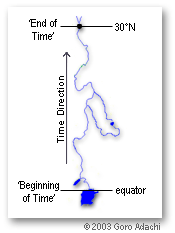 can
be reasonably assumed that the river’s beginning point at the
equator represents the earliest point on the timeline, and Giza/Cairo
at the edge (30°N) the ‘end of time’. (See
Appendix 1 for discussion
on the beginning latitude of the Nile.) can
be reasonably assumed that the river’s beginning point at the
equator represents the earliest point on the timeline, and Giza/Cairo
at the edge (30°N) the ‘end of time’. (See
Appendix 1 for discussion
on the beginning latitude of the Nile.)
The most sensible time-encoding system here would be one based on
latitude, where a linear, northward-moving timeline is superimpose
on the Nile.
To derive a timeline in this system, it is necessary to first have
at least two ‘anchor points’, or 'anchor dates', placed upon the
Nile. The rest would be just a matter of simple calculation. (The
distance between the two anchor points will have the function of a
base unit for the timeline.)
But there needs to be a good rationale
for selecting these points/dates.
For this, we turn to the Giza monuments, evidently an integral part
of the Nile scheme (marking the river’s northern edge). Giza,
through its astronomical alignments, manages to give us just what we
need to turn the ancient river into a tangible map of time.
The key here is Robert Bauval’s popular ‘Orion Correlation Theory’
(or more broadly the ‘Star Correlation Theory’) which traces the Giza layout back to the stars. The basic idea is quite simple. The
theory essentially says that the arrangement of the three great
pyramids standing there closely emulates that of the three Belt
Stars of Orion, the heavenly Osiris.
Bauval demonstrates this first by noting that the smallest pyramid
is slightly offset from the diagonal line made by the other two
pyramids.
He then compares this to a similar offset seen in the
Orion Belt Stars, with the dimmest star congruently corresponding to
the smallest pyramid.
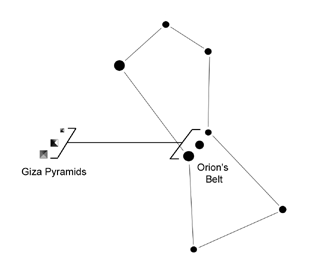
This sky-ground correspondence is
supported by a passage from the ancient Egyptian ‘Pyramid
Texts’ which makes it plain that the pyramid and Osiris-Orion are
closely linked:
O Horus, this King is Osiris [=
Orion], this pyramid of the King is Osiris, this construction of
his is Osiris; betake yourself to it, do not be far from it in
its name of ‘Pyramid’…[16]
Next, based on this initial ‘as above,
so below’ connection, Bauval points out that there was an
extraordinary set of alignments around 10,500 BC:
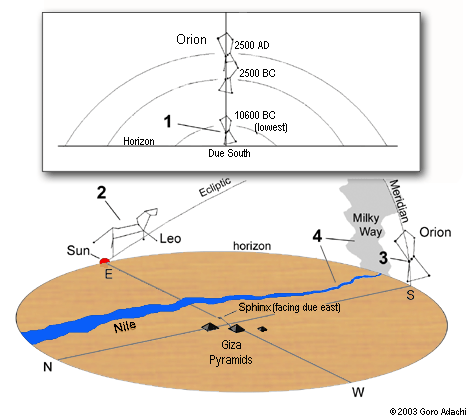
Around 10,500 BC:
-
Orion reached its lowest point
at the meridian in its 26,000-year precessional cycle.
(Precession slowly shifts Orion and other stars up and down
the meridian, the imaginary north-south line drawn in the
sky where the stars achieve their highest daily altitudes.)
-
On the vernal equinox, the Great
Sphinx, directly facing east, witnessed the rising of its
two celestial counterparts - the sun and Leo.
At the moment of equinoctial sunrise (c.
10,500 BC):
-
Orion was positioned right at
the meridian.
-
In the southern sky, the Milky
Way was seen roughly vertical and positioned in such a way
that it appeared to be an extension of the Nile. Orion was
situated just to the right of the celestial river - closely
mimicking the configuration of the Giza pyramids and the
Nile.
It is reasonable to conclude that the
builders of the Giza monuments intended to commemorate the extremely
ancient epoch of 10,500 BC.
We can refine the date by taking a closer look at Point #1, i.e.
Orion’s lowest transit point (‘southern culmination’). It occurred
more exactly c. 10,600 BC. This, then, is our first ‘anchor date’.
As for the second ‘anchor date’, the answer turns out to be the
‘Pyramid Age’ when the pyramids themselves were built - around 2500
BC.
The date can be refined through another Giza celestial alignment,
this time involving the four ‘air shafts’ (or 'star shafts')
emanating from the so-called King’s Chamber and Queen’s Chamber
inside the Great Pyramid.
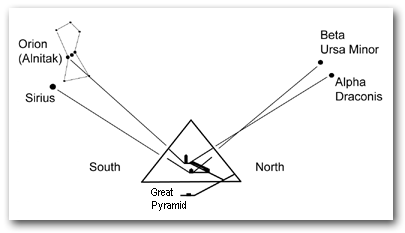
Expanding on the theory of Alexander Badawy and
Virginia Trimble,[17] Bauval found that these shafts,
targeted at the meridian (i.e. due south/north), are angled just
right so that around 2400 BC they aligned with key stars crossing
the meridian ('transit').
The southern shafts were aimed at Alnitak
(of Orion) and Sirius; the northern ones were aimed at Beta Ursa
Minor (‘Kochab’) and Alpha Draconis (‘Thuban’, the ancient Pole
Star).
Bauval claims that these alignments collectively pinpoint c. 2450
BC, but this is not quite accurate. It should be more like c. 2350
BC. All the star-shaft alignments occurred at the latter time except
for Orion’s alignment with the King’s Chamber southern shaft (c.
2490 BC). But as Dr. Thomas G. Brophy points out, the same shaft did
come into alignment with the Galactic Center around 2350 BC.[18]
At this point, then, the Giza monuments have given us two solid
anchor dates, 10,600 BC and 2350 BC.
A Timeline
Emerges
The next step is to figure out where to place these anchor dates
along the Nile.
For 10,600 BC, it is actually a simple matter. Since the ‘10,500 BC
epoch’ appears to signify the mythical ‘First Time’ (Zep Tepi), as
postulated by Bauval and Hancock, it would naturally go to the
source of the Nile at the equator.
It is where ‘time’ begins, as the
Nile flows out of Lake Victoria. In support of this designation, we
find that the same epoch also happens to mark the establishment of
the Nile’s equatorial Lake Victoria outlet.[19]
Additionally, the usage of the equator as the beginning latitude is
strongly encouraged by Giza’s 10,600 BC celestial alignment.
Let us examine it again:
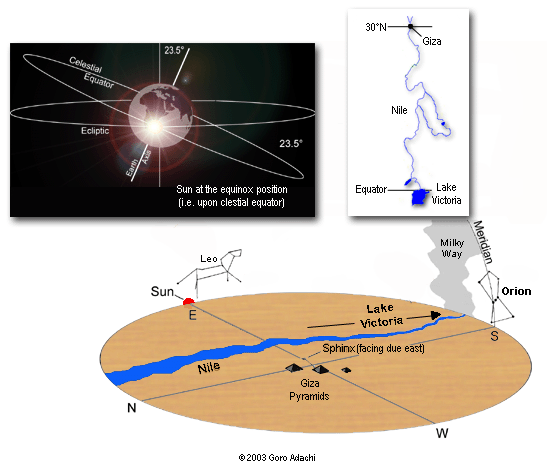
-
Orion was positioned due south and
as close to the horizon as possible, thus guiding our attention
toward the southernmost source of the Nile (Lake Victoria)
situated due south of Giza.
-
Point 1 was accompanied by the
equinoctial sunrise with Leo due east. Since the equinoxes are
when the sun is at the extension of the equator (called the
‘celestial equator’), it tells us that 10,600 BC is to be seen
as an equatorial (anchor) date.
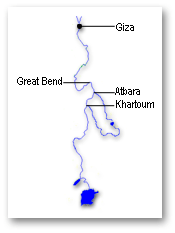 As
for the 2350 BC anchor date, we can assume that it will go to one of
the following key points on the Nile: As
for the 2350 BC anchor date, we can assume that it will go to one of
the following key points on the Nile:
-
the confluence at Khartoum
-
the Atbara confluence
-
the
Great Bend peak
-
Giza/Cairo
The question is: Which one?
A big clue here comes from Sirius and Orion’s Alnitak, two prominent
stars from the Great Pyramid's star-alignment scheme. They happened
to produce the angle 19.5° around 2350 BC.
When Sirius was rising at the horizon as viewed from Giza, Alnitak
we seen hovering 19.5° above the horizon. (See illustration below.)
This suggests that the date 2350 BC and the angle/latitude 19.5° are
to be united. Hence we are encouraged to assign the second anchor
date to the Great Bend’s peak at 19.5°.
There are other clues supporting the arrangement - including the
fact that the general region of the Great Bend (Nubia/Kush) was once
called the ‘Land of the Bow’ (Ta-Seti), which strongly resonates
with the ‘Sirian’ nature of the 2350 BC-19.5°N anchor point, because
Sirius’ various epithets happen to include ‘Bow Star’ (as well as
‘Arrow Star’).
So, with the two anchor points firmly established, we are now ready
to move on to the critical step - the conversion of Nilotic
latitudes into dates.[20]
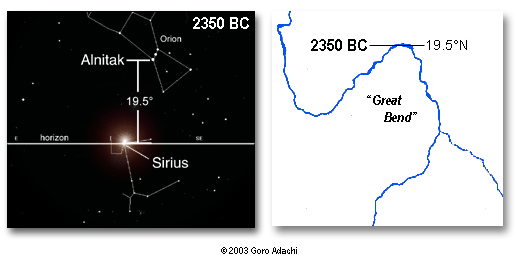
As the highlights below show, what
emerges is a startling timeline:
-
Khartoum at 15.60°N. corresponds
precisely to 4000 BC.
-
The Atbara-Nile confluence at
17.67°N. corresponds to 3124 BC.
-
Giza/Cairo at 30.00°N.
corresponds to AD 2093.
For those familiar with the general
outline of ancient history, the significance of the first two dates,
4000 BC and c. 3100 BC, should be immediately clear. The third date
c. AD 2100 is intriguing too for its close proximity to our own
time.
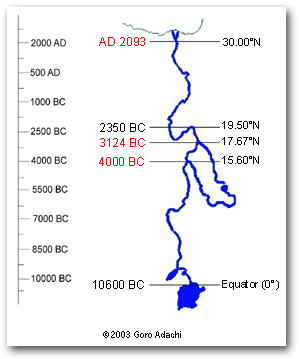
For those not very familiar with ancient
chronology, 4000 BC is in various ways - historically, religiously,
and esoterically - the ‘beginning of the world’:
-
It was around 4000 BC that the first
known high civilization called
Sumer suddenly rose in
Mesopotamia (present Iraq) to begin ‘history’.
-
The year 4004 BC is the standard
Christian date for Adam, the first man, based on the scriptural
calculation done by Archbishop James Ussher in the
mid-seventeenth century (Annales Veteris Testamenti). In his
calculation, Ussher even applied the date 2348 BC to the Great
Flood, which almost exactly matches one of our anchor dates
(2350 BC)!
-
4000 BC is the beginning date used
in the calendar adopted by
Freemasonry - a quasi-esoteric
fraternal organization whose enigmatic tradition can be traced
back to various ancient cultures, including ancient Egypt.
(Remarkably, the highest rank in Scottish Freemasonry is called
‘33rd Degree’ as if in reference to the key Nilotic longitude,
33°E.)
The other ancient date pinpointed, c.
3100 BC, has similar implications:
-
The date coincides with the
beginning of ancient Egypt - none other than the ‘gift of
the Nile’ itself!
-
It was indeed around 3100 BC
that King Menes commenced the Dynastic period as he unified
Lower Egypt and Upper Egypt - an event known as the
‘Unification of the Two Lands’.
-
The date coincides with what the
Mayan calendar calls the ‘Birth of Venus’ (3114 BC), the
beginning of the current age.[21]
-
For the Hindus, too, c. 3100 BC
was the beginning of the present age called Kali Yuga.[22]
It is quite evident that the Nile
Timeline is very meaningful.
Now, before moving on to the next step, let us divide up the Nile
according to the zodiacal Ages, each lasting roughly 2160 years. (We
are currently living near the end of the 'Age of Pisces' and about
to move into the 'Age of Aquarius'.)
The illustration below shows the Nile so
rendered.
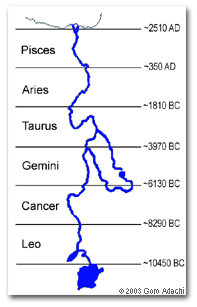
We see that the river covers exactly six
Ages - Leo, Cancer, Gemini, Taurus, Aries, and Pisces. Notice that
the middle section around the Great Bend corresponds to the Age of
Taurus.
This will be shown to have a profound
implication shortly.
Tale of Two Rivers
The historical importance of the Tigris-Euphrates river rivals that
of the Nile.
Just as the Nile gave rise to the great ancient
Egyptian civilization, so did the Tigris-Euphrates to Sumer in
Mesopotamia (modern Iraq), the first high civilization in history.
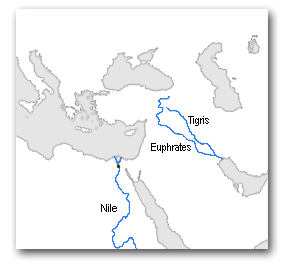
That there is a hidden connection
between the Nile and the Tigris-Euphrates is initially hinted by the
latitudinal position of the latter’s mouth. It is at 30°N exactly - the very latitude of the Nile’s ‘edge’ marked by Giza/Cairo!
This means the Mesopotamian river’s
mouth is in precise alignment with the Great Sphinx’s eternal gaze
which is fixed on the distant horizon due east.
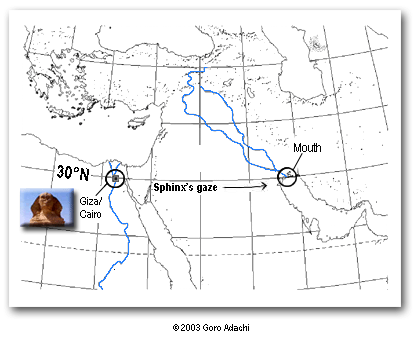
This subsequently leads to the following
observations:
-
The arrangement of the
Tigris-Euphrates - two roughly parallel and diagonal rivers
- resembles that of the Blue Nile and the Atbara.
-
The Tigris-Euphrates’
northernmost region overlaps the Taurus mountain range,
perfectly echoing the Nile tributaries’ northernmost region
coinciding with the ‘Age of Taurus’ segment.
-
There was indeed a widespread
belief in ancient times that the Nile and the Euphrates
‘were but different portions of the same stream’.[23]
-
The epoch marked by the Blue
Nile/Khartoum (c. 4000 BC) approximately coincides with the
rise of Sumer in Mesopotamia, the land of the
Tigris-Euphrates. It flourished throughout the Age of
Taurus.
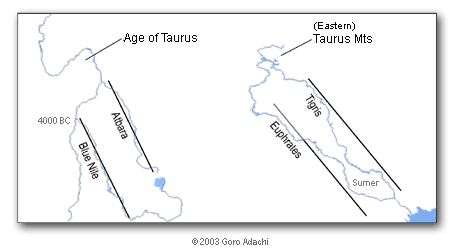
These correspondences unmistakably hint
at some kind of ‘geographical transposition’ scheme.
This is even acknowledged in ancient
myth:
-
The Nile’s Taurus Age section
and the Taurus Mountain in Turkey are both associated with
the saga of the ‘fallen angels’ (the ‘Watchers’, ‘Nephilim’,
or ‘Anunnaki’) and the ‘Great Flood’.
-
The passages in Genesis relating
to the ‘Garden of Eden’ reveal a clear link between the Nile
tributaries and the Tigris-Euphrates.
Point 5 is supported by the work of
researcher Andrew Collins who has come to the conclusion, as
detailed in his book From the Ashes of Angels, that the homeland of
the Watchers (‘fallen angels’) - analogous to Eden - was situated
around the headwaters of the Tigris-Euphrates in Turkish Kurdistan.
He also found that the same location is
where ancient tradition pinpoints as the landing site of the Ark (of
Noah).
But how are the ‘fallen angels’ and the
Ark related to the Nile’s Taurus section?
The answer here is quite
interesting. First, the ‘Taurus’ region around the Great Bend is
very much associated with the notion of a flood, and by extension
the Ark, because the Nile’s annual inundation was caused by the Blue
Nile and Atbara that join the main stream there. The Great Bend
being a ‘great arc’ adds more weight to the connection in that the
words ‘ark’ and ‘arc’ likely derive from the same root.
As for the ‘fallen angels’, the connection is made through
Prometheus, the Greek god who gave ‘fire’ to mankind. Prometheus is
the embodiment of the rebel angels.
This then leads to the following:
-
As if in allusion to the Bend,
Prometheus is closely associated with the idea of
‘churning’, ‘twisting’, or ‘turning’. For instance, the
‘mantha’ part of the Sanskrit term Pramantha (i.e.
Prometheus) has the meaning of ‘churning’.[24]
-
The Vedic fire-god Agni, a form
of pramantha, is said to come from the confluence of the
rivers as if in reference to the Nilotic confluences
(Khartoum and Atbara) of the Great Bend section.[25]
-
The same Agni is associated with
the mythological character Heimdal/Hallinskidi/Vindler whose
name is said to mean ‘a bent, bowed, or slanted stake’ (Hallinskidi)
and ‘to twist, turn, etc.’ (Vindler) - seemingly alluding to
the Great Bend.[26]
There is an even more striking basis for
Point 6 - i.e. the Eden connection - as discussed below.
Four Rivers of
Eden Identified
The region around the Tigris-Euphrates’ headwaters is the site of
Eden which according to Genesis was connected to four rivers, two of
which were the Euphrates and Tigris. The identities of the other two
- called ‘Pishon’ and ‘Gihon’ - have not been conclusively
determined by scholars.
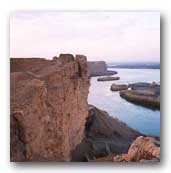
As we examine the relevant biblical passage in Genesis (2:10-14)
with the foregoing findings in mind, however, it becomes clear that
the two mystery rivers are none other than the Blue Nile and the
Atbara!
A river rises in Eden to water the garden; outside, it forms four
separate branch streams. The name of the first is Pishon; it is the
one that winds through the whole land of Havilah, where there is
gold… The name of the second river is Gihon; it is the one that
winds through all of the land of Cush. The name of the third river
is Tigris; it is the one that flows east of Asshur. The fourth river
is the Euphrates.[27]
Where is this ‘land of Cush’ through which the Gihon river is said
to flow?
The shocking answer here is made plain in the
King James
Version of the Bible, according to which the Gihon winds through the
‘land of Ethiopia’ - that is, the land of the Nile tributaries! This
is a rather blatant clue, and yet it was never understood until now.
But the ‘land of Cush’ more accurately refers to the ancient kingdom
of Cush (or Kush) that existed in Nubia as early as 2000 BC. Nubia
closely corresponds to the Nile’s Taurus (Great Bend) region where
Eden would be if the Tigris-Euphrates was ‘transposed’!
And this is
exactly where the Nile indeed ‘winds’ - i.e. the Great Bend - just
as described in the Genesis passage!
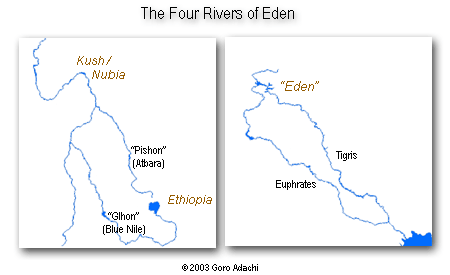
The other Eden river in question called
the ‘Pishon’ is also described as ‘winding’.
But here it is said
that the Pishon winds through the land ‘where there is gold’. Could
this relate in any way to the same region of Nubia/Cush? The answer
is definitely yes. To the Egyptians, Nubia was known primarily as a
land of gold!
To top it off, Graham Hancock informs us
in The Sign and the Seal that,
‘the Abyssinians themselves firmly
believed the Blue Nile to be nothing less than the Gihon of
Genesis 2:13… [and this] was a very old tradition’; in fact,
‘the twin springs regarded as the source of [the Blue Nile] are
known to this day as Giyon by the Ethiopians themselves’.[28]
Hence it can be confidently concluded
here that the ‘Gihon' is the Blue Nile and the ‘Pishon' the Atbara.
The four rivers of Eden have thus been all identified for the first
time in known history.
They are the:
-
Euphrates
-
Tigris
-
Blue Nile
-
Atbara
It is now practically undeniable that the Nile tributaries and the
Tigris-Euphrates are portions of the same scheme and are designed to
interact.
This realization leads to the next big revelation
- indeed, a ‘smoking gun’.
Smoking Gun:
Overlay Interaction
It is revealed when the two ‘Eden river’ systems are brought
together in superimposition.
This is when we realize that we are
looking at the ‘fingerprints of the gods’. That’s the best way to
describe the ‘impossible’ occurrence witnessed here anyway.
Obviously the paths of the two river systems do not match exactly.
But we discover that the Tigris and Euphrates do manage to cross the
two Nile confluences simultaneously (Khartoum and Atbara) in one
particular position. And this is just the beginning.
We find next that, while still in the
same position, the Euphrates’ northern path precisely ‘touches’ the
peak of the Great Bend at 19.5°N 33.0 E!
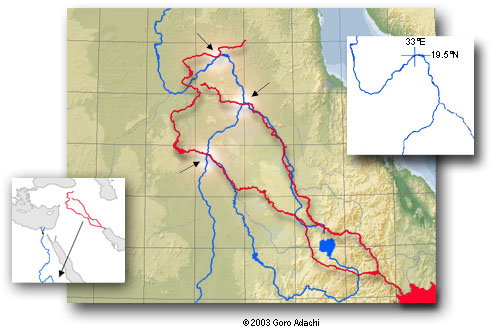
In other words, in one fixed overlay
configuration, the Tigris-Euphrates manages to simultaneously
pinpoint all three key points of the Nile’s Taurus section!
And don't forget that this configuration
is something strongly encouraged by the two rivers’ ‘Taurus’
parallel.
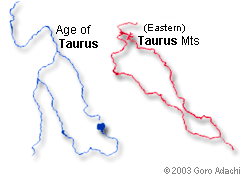
This is still not all. We discover next
that the Euphrates’ Bend-contact point was originally at 39.6°N
latitude.
Recall that ‘39.6°’ is the exact angle
of the Great Pyramid’s southern-lower shaft designed to align with
Sirius in c. 2350 BC - i.e. the very date assigned to the Great
Bend’s apex! (Note also that Sirius and the Great Bend are both
linked to the Nile inundation.)
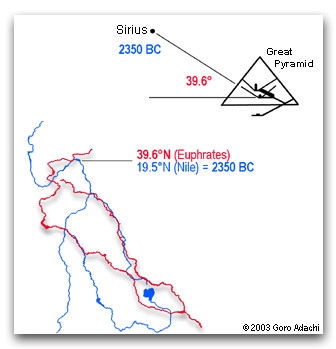
Here are additional observations to
intensify the coherence of the overlay configuration:
-
As already mentioned, the
Tigris-Euphrates’ Taurus mountain region directly overlaps
the Nile’s Taurus-Age section.
-
The Tigris and the Euphrates
very closely follow the Atbara and the Blue Nile
respectively near the Nile junctions.
-
Mount Judi - the traditional
resting place of the Ark - nearly marks the Atbara
confluence.
-
The Tigris-Euphrates’ mouth
(originally at 30°N) appears to rest on the Nile’s 10°N
parallel, the very latitude accentuated by the Blue Nile’s
W-shaped double bend.
-
Lake Tana is seen situated in
southern Mesopotamia and in between the two rivers - i.e.
exactly where the Sumerian civilization resided.
(Note: For the overlay configuration,
the Nile’s longitude 33.0°E running through the Bend-Euphrates
contact point is used as the ‘anchor meridian’, to which the
Tigris-Euphrates’ 40.2°E is aligned. See
Appendix 2 for more on this
issue.)
This is the ‘Eden Overlay Configuration’ (‘EOC’) scheme residing at
the heart of the Time River Theory. With it the earth suddenly
transmutes into a planetary jigsaw puzzle. The overwhelming visual
and conceptual coherence witnessed here virtually proves the
validity of the Time River concept.
There is even an ancient Egyptian drawing - shown below - that
appears to allude to the overlay interaction. It is a depiction of
the ‘Primeval Mound of Creation’ - associated with Osiris - that
bears an uncanny resemblance to the ‘EOC’ arrangement:
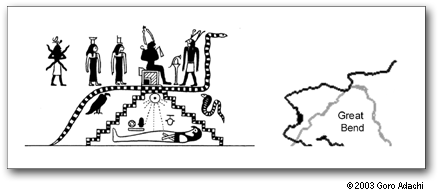
As shocking as these findings are, this
is actually still only the tip of the iceberg. This is the beginning
of a forbidden tale now finally resurfacing from the dark abyss of
time.
The Time River Theory in its entirety is much bigger than what
is presented in this paper, and it is continuously evolving and
expanding. Indeed - believe it or not - there are many more ‘smoking
guns’...
Conclusions &
Portents
In conclusion, this paper has demonstrated that:
-
The design of the Nile works
superbly with the time-marker monuments of Giza.
-
Through the interaction of #1,
the Nile turns into a shockingly precise and meaningful
timeline.
-
The Nile timeline pinpoints the
two earliest and most mysterious ancient civilizations,
Sumer and Egypt.
-
The same two points on the Nile
marking 4000 BC and 3124 BC, plus the 19.5°N/2350 BC anchor
point, are also pinpointed by a ‘transposed’
Tigris-Euphrates (in the ‘Eden Overlay Configuration’).
-
The Tigris-Euphrates is designed
to be a ‘version’ of the Nile tributaries, the Blue Nile and
the Atbara. These two sets of rivers interact coherently in
superimposition.
-
All this is encouraged and
supported by ancient myth.
The Time River system is visually
striking, conceptually elegant, internally consistent, and quite
easy to understand.
It is strongly supported by numerical, archeo-astronomical, textual, and symbolic evidence. And yet its
existence is clearly ‘impossible’ according to the accepted model of
reality. Unless there is a fatal flaw in the theory, this appears to
be a checkmate situation. It is finally reality’s turn to back off.
One key thing that has become abundantly clear from the findings
presented in this paper is that there is a higher intelligence
monitoring - or even guiding - the evolution of mankind, and that we
are not ‘alone’.
But what are we talking about here really? The ‘gods’? The ‘fallen
angels’? Extraterrestrials?
The answer does not come easily. But what we now know for sure is
that we are not the supreme ruler of our domain as many of us had
arrogantly assumed. All history - the past, present, and even future
- is already mapped out and carved in stone, quite literally. But
the difficulty we encounter here is the emerging necessity to
imagine someone or something that is intelligent and powerful enough
to have produced such a planetary-scale ‘time map’.
‘They’ are, however, not totally faceless. For example, we do find
clues in certain ancient Mesopotamian texts.
These describe god-like beings called
the ‘Anunnaki’ designing and digging out the courses of the
Tigris-Euphrates (which is even associated with ‘destinies’):
Now that the destinies of Heaven
and Earth have been fixed,
Trench and canal have been given their right courses,
The banks of the Tigris and the Euphrates have been
established...
[Oh Anunnaki, you great gods of
the sky, what else shall we do?][29]
The Anunnaki of the sky
Made the Igigi bear the workload.
The gods had to dig out canals,
Had to clear channels, the lifelines of the land...
The gods dug out the Tigris river (bed)
And then dug out the Euphrates.[30]
Elsewhere we are told that the god named
Enlil was,
‘in charge of the gods who toiled endlessly away day and
night, year after year, digging out the Euphrates and the
Tigris’.[31]
It is also written that, to keep the Tigris’ waters
from going east into the mountains, the ‘lord directed (his) great
intelligence to it’ and built a dike to control the river’s
course.[32]
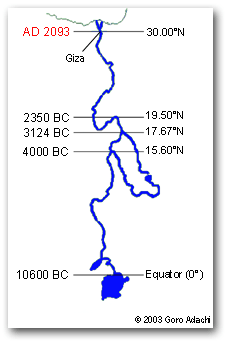
A message in a bottle from the ‘Anunnaki’ gods - this seems to be
what the Time River system represents. And the indications are that
the intended recipient is those living in the the 21st century, i.e.
us.
After all, it wouldn’t make much sense if history ended before
anyone has read the message, and we are already part of the last
generations facing the imminent arrival of the ‘end of time’ c. AD
2100 marked by Giza at the northern edge of the Nile timeline.
(It
is certainly appropriate that Giza is the site of the great pyramids
and the Sphinx, i.e. monuments often thought to be a time capsule of
some kind.)
So there is actually a sense of ominous urgency. Because time is
short. And we can only infer that it must be very important for us
to decipher the mysterious message from the abyss of time, perhaps
so that we can prepare ourselves for the mysterious ‘Event X’
scheduled for our immediate future.
And it promises to be the most
profound event for human civilization in all history.

It is quite synchronistic that the author’s book The Time Rivers
came out in 2003 to reveal the Time River scheme to the general
public, because 2003 happens to be the year of the
Earth’s historic
close encounter with Mars - the closest in recorded history.
As
discussed in the book, the ‘edge of time’ (c. AD 2100) turns out to
be inseparable from the Red Planet.
Consider this for instance: the
Great Sphinx there, the guardian of Giza, had the same name as Mars
in ancient Egypt; and the name of the present Egyptian capital right
next to Giza, Cairo, denotes ‘Mars’.
Indeed,
Mars is actually the main theme carried by the entire
Time
River system. The Red Planet, it appears, represents none other than
the realm of our own Genesis and destiny. It signifies an essential,
but secret, part of who we are, where we came from, and where we are
going.
The explosive truth had been hiding in the shadows for millennia - patiently waiting for its time to rise back into the light. At the
beginning of the third millennium, the secret is finally out.
This paper represents just the tip of the iceberg, just the
beginning of a momentous story. But it opens up the Gateway...
Appendix 1
The Nile’s Beginning Latitude
While ‘30’ is a ‘temporal number’, based on the orbital periods of
Saturn and the Moon it may be expressed more precisely as ~29.5. We
find that Saturn’s orbit around the sun takes ~29.46 earth-years and
the Moon’s orbit around the earth (the ‘synodic month’) is ~29.55
earth-days.
Remarkably, when examined closely the Nile too reveals itself to be
about 29.5 degrees in latitude because the river’s beginning point
happens to be just slightly north of the equator. (Somewhere between
0.4°N and 0.5°N.[1])
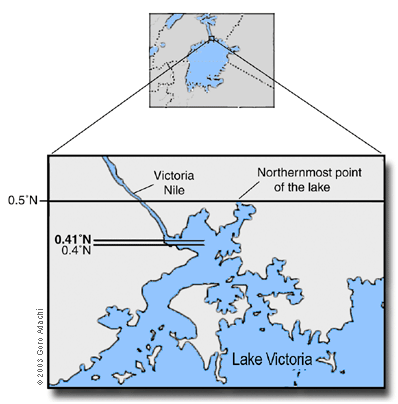
The slight ambiguity surrounding the
river’s beginning latitude can be resolved through proportional
analysis.
We find that using 0.41°N. (= ~0° 25’N.), the ratio
between the resultant length of the Nile and the extra 0.41 degrees
would become 29.59:0.41 or ~72.17:1, which could then be simplified
to 72:1.[2] The significance here is that ‘72’ is known to be
something of a ‘sacred’ number that shows up frequently in ancient
myths.
As propounded in the book
Hamlet’s Mill, the esoteric importance of
the number ‘72’ can be traced back to the stars - specifically a
astronomical phenomenon known as ‘precession’, an extremely slow
(apparent) movement of the stars caused by the slight ‘wobbling’ of
the Earth’s axis. The basic unit of this very slow time-keeping
mechanism - the vernal point shifting 1 degree - happens to equal 72
years.
So ‘72’ can be seen as a ‘time number’.
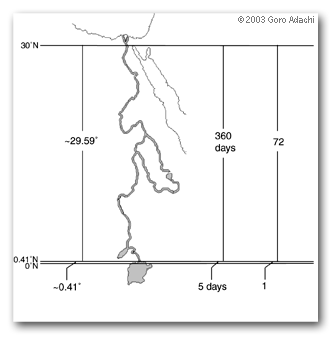
Corroborating this view is the fact that
the ancient Egyptian calendar saw the year as being 360 days with 5
extra ‘epagomenal’ days during which five important gods - Osiris,
Horus, Seth, Isis, and Nephthys - were said to have been born. The
ratio between 360 days and 5 days happens to equal 72:1.
These consequently tell us that 0.41°N
(which produces the 72:1 ratio) is to be considered the designated
beginning latitude of the Nile.
Appendix 2
On Map Projections and Interaction
Working with maps without understanding their subtle mechanics can
easily lead to inconsistency and confusion.
The level of complexity
involved is actually quite surprising. Although probably of minute
significance to the average reader, those seeking to investigate the
Time River system in depth are advised to know the following basic
points.
Orthographic Azimuthal Projection
Because there are countless ways to express a spherical globe on a
two-dimensional plane, there are many types of map projections.
People use different projections for different purposes.
For the Time River overlay scheme, we are forced to use a virtual
globe computer program and nothing less. Conventional maps
containing various spatial distortions are just not suited for the
purpose of this operation - which is to see two or more different
geographical regions in superimposition. We really need the digital
flexibility and precision of a virtual globe to create large-scale
geographical overlays.
And preferably the simulated Earth is an ‘orthographic azimuthal
projection’. It shows a natural-looking globe, but its geometry is
as viewed from infinitely far away. (See Figures A2.1 and A2.2.)

Figure A2.1
Orthographic
Azimuthal Projection.
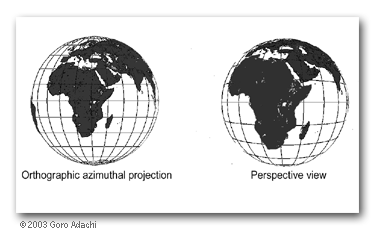
Figure A2.2
Comparison.
If the required operation is to just make a map overlay, it doesn’t
really matter whether the virtual globe is an orthographic azimuthal
projection or a truer representation of the earth (i.e. a
perspective view from a fixed point in space), as long as the size,
or distance, is consistent.
But if the operation requires you to combine a map with something
else (such as a sky projection or a painting), the globe’s
projection type becomes an important issue, because there would be
varying results depending on the selection.
The orthographic azimuthal projection becomes a better choice in
this case because it would eliminate one variable - the distance
between the viewpoint and the earth - in determining the overlay
configuration. This makes the whole process much simpler.
Aligning Maps
How to align multiple maps/globes in superimposition is another
important and tricky issue for the Time Rivers.
It turns out that
comparing two areas of the planet separated by a great distance - especially in terms of latitude
- is not as simple as it sounds.
First, it is imperative that the centers of all the projections used
in an overlay composite would coincide when put in place so that the
spatial distortions are uniform among the maps.
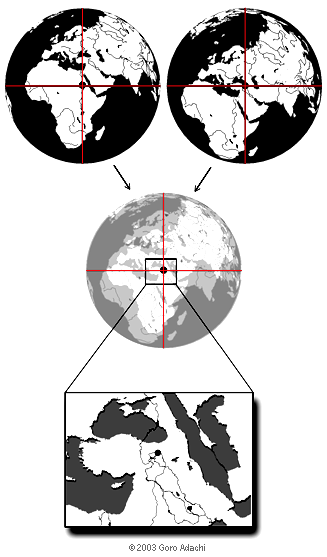
Figure A2.3
How to produce a
large-scale map overlay.
(The end product of
this example is the ‘Eden Overlay Configuration’ discussed in the
Nile Decoded paper.)
But this alone still does not ensure consistency.
We also need to
carefully decide where to place the centers of the projections
before bringing them together, as this would actually produce
varying results. (See Figure A2.4 for a demonstration of this.)
This
process can be rephrased as choosing the ‘central meridian’ or, as I
like to say, ‘anchor meridian’.
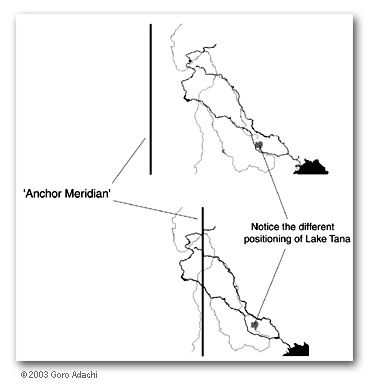
Figure A2.4
The position of the
anchor meridian (central meridian) affects the overlay
configuration.
As made clear in the author’s book The
Time Rivers, the prime ‘anchor meridian’ selected, or detected, for
the Time River system is 33°E longitude.
All these points should be carefully
taken into account when attempting to replicate, confirm, or
criticize findings presented in the book or the Nile Decoded paper.
The Nile
Denial
A Guide to Objective Evaluation
August 9, 2003
Regardless of merit, a radical new theory that wildly contradicts
the mainstream model of reality will not be welcomed by academics.
Depending on the theory’s strength and clarity, however, the general
public may respond positively. And if the buzz becomes loud enough,
even the mainstream media may decide to pay attention.
This is when certain elements of academia become alarmed. They feel
their territory has been infringed upon - perceiving the theory as
some alien virus contaminating the holy ground of ‘science’.
Instinctively, they will attack the ‘virus’ until it is dead.
One way or another, therefore, most ‘heretical’ theories are forced
to fade into oblivion. Often this fate is justifiable, but certainly
not always. The process is obviously prone to throwing out the baby
with the bath water - as there are always exceptions.
The Time River Theory, I contend, is the ‘baby’ that should not be
automatically thrown out. A brief guide to logical thinking is
provided below to help implement a fair evaluation process that will
hopefully bear this out.
Intellectual Vaccination
One effective way to ‘vaccinate’ the
mind against flawed reasoning/criticism is to cite examples.
Another is to provide preemptive answers to anticipated
questions and objections.
So let us first take a look at what are known as ‘informal
fallacies’, which are various types of illogical arguments (in
this case against the Time River Theory):
Straw Man
Example:
“The idea that our ancestors dug
out the paths of the major rivers with shovels, or that
little green men from Orion came here to construct the
rivers is extremely implausible.”
This statement is distorting what
the Time River Theory claims. The theory does not argue that
ancient people created the rivers with primitive tools, nor does
it argue that space aliens produced the Time Rivers. (These are
mere speculative possibilities). A valid argument has to argue
against the true form of the theory, not a conveniently
corrupted form.
Appeal of Force
Example:
“The organization CSICOP
believes that the Time River Theory is one big joke, and it
believes that any scholars who take the theory seriously
should be investigated for their intellectual integrity.”
This statement is essentially a
threat and has nothing to do with the legitimacy of the Time
River Theory. Many academics often succumb to this type of peer
pressure, and their intellectual integrity does go out the
window.
Appeal of Authority
Example:
“The whole Time River thing is
surely utter nonsense because according to Dr. [X], a
respected expert on geology, it is absolutely laughable to
think that the Nile, the Tigris-Euphrates, etc. have been
intelligently designed to transmit some strange information
across time.”
Citing expert opinions does not
translate to a valid argument, as being an expert does not make
one infallible. Since the Time River Theory covers a lot of
ground, one should be particularly careful about ‘expert
opinions’.
False Alternative
Example:
“Because it is clear that the
ancients did not have the technological capability to
construct major river systems, the Time Rivers simply cannot
be real.”
This is a flawed argument because it
fails to take into account other possibilities. For example,
perhaps it was a covert group of highly advanced beings from
elsewhere (spatial and/or temporal) that created the Time River
system, leaving behind no clear evidence of their existence. Or
perhaps it was some unknown non-physical ‘force’ that gave rise
to the Time Rivers - not unlike the ‘force’ of evolution that
has managed to produce incredibly complex life forms on this
planet.
Ad Hominem (Personal
Attack)
Example:
“Since Goro Adachi is not a
member of academia, there is no reason to take his ideas
seriously.”
My credentials (or character) have
nothing to do with the validity of the Time River Theory itself.
For example, if it were a convicted murderer who came up with
the theory of Relativity, would this alone cause the theory to
become invalid? No. It would still be just as valid.
Appeal to the Masses
Example:
“Everyone I have talked to has
told me that the Time River Theory is just a product of an
overactive imagination, so obviously it must be just that.”
At one time, almost everyone would
have told you that the earth was the center of the universe.
Enough said.
Begging the Question
Example:
“The Time River Theory is
clearly fallacious because it claims that the Nile River
carries an intelligent message, which it does not.”
This is a circular argument because
the premise and the conclusion are stating essentially the same
thing. This is like saying: ‘Einstein must have been insane,
because it is clear that he was crazy’.
Appeal to Pity
Example:
“The existence of the Time River
system will upset many nice religious people. So, please, I
beg everyone to reject the theory!”
Truth does not care whether it hurts
anyone or anything. A valid idea does not stop being valid just
because it is considered undesirable on an emotional level.
Composition
Example:
“In his book, Goro Adachi gets
the date for [event X] wrong and he also confuses [event Y]
with [event Z]. If he is inaccurate about these things, we
can safely assume that the entire content of his book is
pure rubbish.”
If this argument were valid, it
would also be valid to state that the United States is a stupid
nation because there are some dumb Americans.
Converse Accident
Example:
“Since many theories put forward
by researchers in the ‘alternative history’ field have
already been debunked, the Time River Theory must be flawed
as well.”
Racial profiling is based on the
same thinking process. Even if there are patterns and trends,
with room for exceptions, individual cases must be judged
separately.
Preemptive Responses
The following are ‘preemptive’ responses to anticipated
objections to the Time River Theory:
Criticism: Since we have
no physical or historical evidence suggesting that any of
our rivers are artificial, the theory must be considered a
baseless speculation.
Response: In terms of geology, it is true that the
rivers in question are not considered anomalous (as far as I
know). The Time River Theory, however, does not claim
anything tangible regarding the process responsible for the
rivers’ intricate designs. So the apparent naturalness of
the rivers’ geology does not invalidate the theory.
How the rivers attained their
seemingly intelligent arrangements is still an ‘X factor’ - a
mystery. If the Time River Theory was weak, then this missing
piece could cast more doubt on its validity.
But because the
theory is actually very strong without the missing piece, a more
reasonable approach would be to put effort into figuring out
what the mechanism ‘X’ may be, instead of lazily viewing it as
evidence against the theory.
Criticism: The Time River
theory necessitates the existence of an astoundingly
advanced group of people in the distant past, and yet we
have no evidence for that.
Response: This is not quite true. We have the Giza
monuments from the dawn of history, for instance, which
still boggle the mind of modern man. Indeed, even with
today’s technology it would still be extremely difficult, if
not impossible, to replicate them. And while the ancient
Egyptian culture in general may not have been very advanced
by today’s standard, we do detect a curious disconnect
between the intellectual sophistication expressed by the
Giza monuments and what we are taught about the ancient
Egyptians. It is almost as if there was a small but truly
advanced elite group that guided the building of the
monuments from behind the scenes.
This is an important clue suggesting
that our view of history may be quite superficial.
And it would
certainly be naïve for us to assume that the intelligence
responsible for the Time River system would have left their
cultural ‘footprints’ behind.
If the intelligence was powerful
and sophisticated enough to have produced the Time Rivers, then
it surely must have been very much aware of the importance of
leaving, or not leaving, evidence of its existence behind.
Or,
to put it another way, it is quite feasible that we are today
seeing what the intelligence in question had intended us to see.
Thus, absence of evidence certainly
does not represent evidence of absence here.
Criticism: Since rivers’
paths change with time, they cannot possibly carry coded
messages for a long period. Consequently, whatever their
layouts may indicate today must be of no significance.
Response: This is seemingly a good point. But it is
presumptuous. In view of the level of intelligence required,
it’s actually more reasonable to hypothesize that the
creators of the Time Rivers were well aware of the
inevitable future geological changes. The more coherent the
encoded message is today, the more probable it is that the
changing river courses do not represent corruption but
pre-arranged evolution.
Criticism: The
angle/latitude 19.5° is central to the Time River scheme,
and yet its significance originally derives from the
questionable geometric interpretation of the Cydonia
structures on Mars. Similarly, the Orion Correlation Theory,
a major part of the Time River design, is still a
controversial theory. This means that the Time River theory
is built on a very shaky foundation.
Response: The significance of 19.5° does not rely on
the Martian ‘monuments’. The angle is very much meaningful
in terms of pure geometry, as it’s considered a ‘tetrahedral
constant’ (t). So, regardless of the legitimacy of the
Cydonia research, the importance of 19.5° is a geometric
fact.
As for the Orion Correlation Theory
(developed by Robert Bauval), it is true that some academics are
not fond of it.
But as mentioned in Chapter 3 [of the book The
Time Rivers], those critics’ arguments are quite lame. In almost
every case, they are infected with the fallacy of ‘composition’
(where some little inconsistency is somehow treated as a proof
of the illegitimacy of the whole theory).
And it is also
important to point out that the Time River Theory does not
depend on the validity of the Orion Correlation Theory.
The rivers’ overlay/transposition
schemes alone are solid enough to make the theory compelling.
Criticism: A scientific
theory must be falsifiable.
Response: Falsifiability - the capability to be
falsified - is a key scientific principle and it is clearly
met by the Time River theory. Although the theory has many
components with varying levels of certainty, what is at the
core are numerically and geometrically precise findings that
are tangible and falsifiable.
References
[1] Even though the southern
most source of the Nile is technically the Ruvironza River
which drains into Lake Victoria, the first river to bear the
name ‘Nile’ is the Victoria Nile that comes out from Lake
Victoria approximately at the equator. To all intents and
purposes, Lake Victoria can be considered the source of the
Nile and the river begins roughly at the equator.
[2]
www.enterprisemission.com/Path-sphinx.html
[3] Livio Catullo Stecchini, ‘Notes on the Relation of
Ancient Measures to the Great Pyramid’, in Peter Tompkins,
Secrets of the Great Pyramid (New York: Galahad Books,
1997), p.292.
[4] Since the practice of dividing up the circle into 360
degrees was already in use at the time of the Sumerians (the
first known high civilization in history), comparing
latitudinal measurements, such as 30°, to other measurements
such as 30 years and 30 days should not be any more
arbitrary than comparing 30 years to 30 days. Incidentally,
30 days is the length of the ‘reign of Saturn’ (Robert
Graves, The White Goddess, p.163).
[5] Margaret Bunson, The Encyclopedia of Ancient Egypt (New
York: Gramercy Books, 1991), ‘sed’.
[6] See, for example, Giorgio de Santillana and Hertha von
Dechend, Hamlet’s Mill (Boston: David R. Godine, 1977),
p.201; J.E. Cirlot, A Dictionary of Symbols (New York:
Barnes & Noble Books, 1995), ‘River’.
[7] See Giorgio de Santillana and Hertha von Dechend,
Hamlet’s Mill, pp.134-5, 373-6.
[8] Plutarch, On Isis and Osiris, 363E.
[9] Robert Graves, The White Goddess (New York: Farrar,
Straus and Giroux, 1948), p.277, cf. Hamlet’s Mill, pp.200,
209.
[10] Jean Chevalier and Alain Gheerbrant, Dictionary of
Symbols (Penguin Books, 1996), ‘ibis’.
[11] Rundle Clark, Myth and Symbol in Ancient Egypt (New
York: Grove Press, 1960), p.246.
[12] E. A. Wallis Budge, The Book of the Dead (New York:
Arkana, 1989), p.598.
[13] Anada K. Coomarswamy, Myths of the Hindus and Buddhists
(New York: Dover Publications, 1967), p.384, cited in Graham
Hancock and Santha Faiia, Heaven’s Mirror (New York: Crown
Publishers, 1998), p.198.
[14] The Osiris-Saturn identification is acknowledged by
mythologist Robert Graves who writes in The White Goddess
(p.197), ‘…Osiris, the Egyptian Saturn’.
[15] Richard Hinckley Allen, Star Names: Their Lore and
Meaning (New York: Dover Publications, 1963), p.308.
[16] Pyramid Texts, line 1657.
[17] See Robert Bauval and Adrian Gilbert, The Orion Mystery
(New York: Crown Publishers, 1994), pp.99-103, 237-241.
[18] Thomas G. Brophy, The Origin Map (Writers Club Press,
2002), pp.86-9.
[19] D. A. Livingstone, ‘The Nile - Palaeolimnology of
Headwaters’, in Rzóska (ed.), The Nile, Biology of an
Ancient River, pp.23-5, 27; Said, The Geological Evolution
of the River Nile, p.6.
[20] Corresponding year for latitude L = [(10600-2350)/19.5]
x L - 10600. (If the resultant number is a negative number,
it means it is a ‘BC’ date. Also, if the year yielded is
zero or positive, technically an extra year has to be added
to make up for the nonexistence of the year ‘0 AD’.)
[21] See, for example, Adrian Gilbert and Maurice Cotterell,
The Mayan Prophecies (Rockport, MA: Element Books, 1995),
pp.33, 136, 184.
[22] Coomarswamy, Myths of the Hindus and Buddhists, p.393,
cited in Hancock, Heaven’s Mirror, p.150.
[23] Allen, Star Names, p.216.
[24] See de Santillana and von Dechend, Hamlet’s Mill,
pp.139-40, 159, 377-383.
[25] Ibid., pp.140, 382, 429.
[26] Ibid., pp.157-9.
[27] Speiser (trans.), The Anchor Bible: Genesis, Genesis
2:10-14.
[28] Graham Hancock, The Sign and the Seal (New York:
Touchstone, 1993), pp.205, 450.
[29] Alexander Heidel, The Babylonian Genesis (Chicago:
University of Chicago Press, 1951), pp.68-71.
[30] From the Atrahasis Epic (Tablet 1).
[31] Thorkild Jacobsen, The Treasures of Darkness (London:
Yale University Press, 1976), p.117
[32] Ibid., pp.130-1.
|

 position
that the discovery of the Time Rivers heralds the last tick of the
‘time bomb’ that ends the illusion of the ‘Matrix’, so to speak. The
new reality lets us discern who we really are, where we came from,
and where we are going.
position
that the discovery of the Time Rivers heralds the last tick of the
‘time bomb’ that ends the illusion of the ‘Matrix’, so to speak. The
new reality lets us discern who we really are, where we came from,
and where we are going. 































